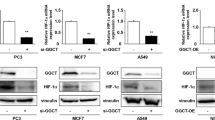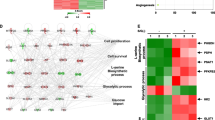Abstract
Hypoxia-inducible factors (HIFs) mediate metabolic reprogramming in response to hypoxia. However, the role of HIFs in branched-chain amino acid (BCAA) metabolism remains unknown. Here we show that hypoxia upregulates mRNA and protein levels of the BCAA transporter LAT1 and the BCAA metabolic enzyme BCAT1, but not their paralogs LAT2-4 and BCAT2, in human glioblastoma (GBM) cell lines as well as primary GBM cells. Hypoxia-induced LAT1 protein upregulation is mediated by both HIF-1 and HIF-2 in GBM cells. Although both HIF-1α and HIF-2α directly bind to the hypoxia response element at the first intron of the human BCAT1 gene, HIF-1α is exclusively responsible for hypoxia-induced BCAT1 expression in GBM cells. Knockout of HIF-1α and HIF-2α significantly reduces glutamate labeling from BCAAs in GBM cells under hypoxia, which provides functional evidence for HIF-mediated reprogramming of BCAA metabolism. Genetic or pharmacological inhibition of BCAT1 inhibits GBM cell growth under hypoxia. Together, these findings uncover a previously unrecognized HIF-dependent metabolic pathway that increases GBM cell growth under conditions of hypoxic stress.





Similar content being viewed by others
References
Liberti MV, Locasale JW (2016) The Warburg effect: how does it benefit cancer cells? Trends Biochem Sci 41(3):211–218. https://doi.org/10.1016/j.tibs.2015.12.001
Hensley CT, Wasti AT, DeBerardinis RJ (2013) Glutamine and cancer: cell biology, physiology, and clinical opportunities. J Clin Investig 123(9):3678–3684. https://doi.org/10.1172/JCI69600
Coloff JL, Murphy JP, Braun CR, Harris IS, Shelton LM, Kami K, Gygi SP, Selfors LM, Brugge JS (2016) Differential glutamate metabolism in proliferating and quiescent mammary epithelial cells. Cell Metab 23(5):867–880. https://doi.org/10.1016/j.cmet.2016.03.016
Takano T, Lin JH, Arcuino G, Gao Q, Yang J, Nedergaard M (2001) Glutamate release promotes growth of malignant gliomas. Nat Med 7(9):1010–1015. https://doi.org/10.1038/nm0901-1010
Yudkoff M (1997) Brain metabolism of branched-chain amino acids. Glia 21(1):92–98
Tonjes M, Barbus S, Park YJ, Wang W, Schlotter M, Lindroth AM, Pleier SV, Bai AHC, Karra D, Piro RM, Felsberg J, Addington A, Lemke D, Weibrecht I, Hovestadt V, Rolli CG, Campos B, Turcan S, Sturm D, Witt H, Chan TA, Herold-Mende C, Kemkemer R, Konig R, Schmidt K, Hull WE, Pfister SM, Jugold M, Hutson SM, Plass C, Okun JG, Reifenberger G, Lichter P, Radlwimmer B (2013) BCAT1 promotes cell proliferation through amino acid catabolism in gliomas carrying wild-type IDH1. Nat Med 19(7):901–908. https://doi.org/10.1038/nm.3217
Nawashiro H, Otani N, Shinomiya N, Fukui S, Ooigawa H, Shima K, Matsuo H, Kanai Y, Endou H (2006) L-type amino acid transporter 1 as a potential molecular target in human astrocytic tumors. Int J Cancer 119(3):484–492. https://doi.org/10.1002/ijc.21866
Wang GL, Jiang BH, Rue EA, Semenza GL (1995) Hypoxia-inducible factor 1 is a basic-helix-loop-helix-PAS heterodimer regulated by cellular O2 tension. Proc Natl Acad Sci USA 92(12):5510–5514
Tian H, McKnight SL, Russell DW (1997) Endothelial PAS domain protein 1 (EPAS1), a transcription factor selectively expressed in endothelial cells. Genes Dev 11(1):72–82
Gu YZ, Moran SM, Hogenesch JB, Wartman L, Bradfield CA (1998) Molecular characterization and chromosomal localization of a third alpha-class hypoxia inducible factor subunit, HIF3alpha. Gene Expr 7(3):205–213
Semenza GL, Jiang BH, Leung SW, Passantino R, Concordet JP, Maire P, Giallongo A (1996) Hypoxia response elements in the aldolase A, enolase 1, and lactate dehydrogenase A gene promoters contain essential binding sites for hypoxia-inducible factor 1. J Biol Chem 271(51):32529–32537
Semenza GL, Roth PH, Fang HM, Wang GL (1994) Transcriptional regulation of genes encoding glycolytic enzymes by hypoxia-inducible factor 1. J Biol Chem 269(38):23757–23763
Kim JW, Tchernyshyov I, Semenza GL, Dang CV (2006) HIF-1-mediated expression of pyruvate dehydrogenase kinase: a metabolic switch required for cellular adaptation to hypoxia. Cell Metab 3(3):177–185. https://doi.org/10.1016/j.cmet.2006.02.002
Metallo CM, Gameiro PA, Bell EL, Mattaini KR, Yang J, Hiller K, Jewell CM, Johnson ZR, Irvine DJ, Guarente L, Kelleher JK, Vander Heiden MG, Iliopoulos O, Stephanopoulos G (2011) Reductive glutamine metabolism by IDH1 mediates lipogenesis under hypoxia. Nature 481(7381):380–384. https://doi.org/10.1038/nature10602
Wise DR, Ward PS, Shay JE, Cross JR, Gruber JJ, Sachdeva UM, Platt JM, DeMatteo RG, Simon MC, Thompson CB (2011) Hypoxia promotes isocitrate dehydrogenase-dependent carboxylation of alpha-ketoglutarate to citrate to support cell growth and viability. Proc Natl Acad Sci USA 108(49):19611–19616. https://doi.org/10.1073/pnas.1117773108
Elorza A, Soro-Arnaiz I, Melendez-Rodriguez F, Rodriguez-Vaello V, Marsboom G, de Carcer G, Acosta-Iborra B, Albacete-Albacete L, Ordonez A, Serrano-Oviedo L, Gimenez-Bachs JM, Vara-Vega A, Salinas A, Sanchez-Prieto R, Martin del Rio R, Sanchez-Madrid F, Malumbres M, Landazuri MO, Aragones J (2012) HIF2alpha acts as an mTORC1 activator through the amino acid carrier SLC7A5. Mol Cell 48(5):681–691. https://doi.org/10.1016/j.molcel.2012.09.017
Luo W, Hu H, Chang R, Zhong J, Knabel M, O'Meally R, Cole RN, Pandey A, Semenza GL (2011) Pyruvate kinase M2 is a PHD3-stimulated coactivator for hypoxia-inducible factor 1. Cell 145(5):732–744. https://doi.org/10.1016/j.cell.2011.03.054
Luo W, Chen I, Chen Y, Alkam D, Wang Y, Semenza GL (2016) PRDX2 and PRDX4 are negative regulators of hypoxia-inducible factors under conditions of prolonged hypoxia. Oncotarget 7(6):6379–6397. https://doi.org/10.18632/oncotarget.7142
Chen Y, Zhang B, Bao L, Jin L, Yang M, Peng Y, Kumar A, Wang JE, Wang C, Zou X, Xing C, Wang Y, Luo W (2018) ZMYND8 acetylation mediates HIF-dependent breast cancer progression and metastasis. J Clin Investig 128(5):1937–1955. https://doi.org/10.1172/JCI95089
Bao L, Chen Y, Lai HT, Wu SY, Wang JE, Hatanpaa KJ, Raisanen JM, Fontenot M, Lega B, Chiang CM, Semenza GL, Wang Y, Luo W (2018) Methylation of hypoxia-inducible factor (HIF)-1alpha by G9a/GLP inhibits HIF-1 transcriptional activity and cell migration. Nucleic Acids Res 46(13):6576–6591. https://doi.org/10.1093/nar/gky449
Yang C, Ko B, Hensley CT, Jiang L, Wasti AT, Kim J, Sudderth J, Calvaruso MA, Lumata L, Mitsche M, Rutter J, Merritt ME, DeBerardinis RJ (2014) Glutamine oxidation maintains the TCA cycle and cell survival during impaired mitochondrial pyruvate transport. Mol Cell 56(3):414–424. https://doi.org/10.1016/j.molcel.2014.09.025
Schodel J, Oikonomopoulos S, Ragoussis J, Pugh CW, Ratcliffe PJ, Mole DR (2011) High-resolution genome-wide mapping of HIF-binding sites by ChIP-seq. Blood 117(23):e207–217. https://doi.org/10.1182/blood-2010-10-314427
Boado RJ, Li JY, Nagaya M, Zhang C, Pardridge WM (1999) Selective expression of the large neutral amino acid transporter at the blood–brain barrier. Proc Natl Acad Sci USA 96(21):12079–12084
Yun DW, Lee SA, Park MG, Kim JS, Yu SK, Park MR, Kim SG, Oh JS, Kim CS, Kim HJ, Kim JS, Chun HS, Kanai Y, Endou H, Wempe MF, Kim DK (2014) JPH203, an L-type amino acid transporter 1-selective compound, induces apoptosis of YD-38 human oral cancer cells. J Pharmacol Sci 124(2):208–217
Bodoy S, Fotiadis D, Stoeger C, Kanai Y, Palacin M (2013) The small SLC43 family: facilitator system l amino acid transporters and the orphan EEG1. Mol Aspects Med 34(2–3):638–645. https://doi.org/10.1016/j.mam.2012.12.006
Luo W, Wang Y (2018) Epigenetic regulators: multifunctional proteins modulating hypoxia-inducible factor-alpha protein stability and activity. Cell Mol Life Sci 75(6):1043–1056. https://doi.org/10.1007/s00018-017-2684-9
Ananieva EA, Patel CH, Drake CH, Powell JD, Hutson SM (2014) Cytosolic branched chain aminotransferase (BCATc) regulates mTORC1 signaling and glycolytic metabolism in CD4+ T cells. J Biol Chem 289(27):18793–18804. https://doi.org/10.1074/jbc.M114.554113
Conway ME, Yennawar N, Wallin R, Poole LB, Hutson SM (2002) Identification of a peroxide-sensitive redox switch at the CXXC motif in the human mitochondrial branched chain aminotransferase. Biochemistry 41(29):9070–9078. https://doi.org/10.1021/bi020200i
Coles SJ, Hancock JT, Conway ME (2012) Differential redox potential between the human cytosolic and mitochondrial branched-chain aminotransferase. Acta Biochim Biophys Sin (Shanghai) 44(2):172–176. https://doi.org/10.1093/abbs/gmr103
Conway ME, Coles SJ, Islam MM, Hutson SM (2008) Regulatory control of human cytosolic branched-chain aminotransferase by oxidation and S-glutathionylation and its interactions with redox sensitive neuronal proteins. Biochemistry 47(19):5465–5479. https://doi.org/10.1021/bi800303h
Conway ME, Poole LB, Hutson SM (2004) Roles for cysteine residues in the regulatory CXXC motif of human mitochondrial branched chain aminotransferase enzyme. Biochemistry 43(23):7356–7364. https://doi.org/10.1021/bi0498050
Yennawar NH, Islam MM, Conway M, Wallin R, Hutson SM (2006) Human mitochondrial branched chain aminotransferase isozyme: structural role of the CXXC center in catalysis. J Biol Chem 281(51):39660–39671. https://doi.org/10.1074/jbc.M607552200
El Hindy M, Hezwani M, Corry D, Hull J, El Amraoui F, Harris M, Lee C, Forshaw T, Wilson A, Mansbridge A, Hassler M, Patel VB, Kehoe PG, Love S, Conway ME (2014) The branched-chain aminotransferase proteins: novel redox chaperones for protein disulfide isomerase-implications in Alzheimer's disease. Antioxid Redox Signal 20(16):2497–2513. https://doi.org/10.1089/ars.2012.4869
Coles SJ, Easton P, Sharrod H, Hutson SM, Hancock J, Patel VB, Conway ME (2009) S-Nitrosoglutathione inactivation of the mitochondrial and cytosolic BCAT proteins: S-nitrosation and S-thiolation. Biochemistry 48(3):645–656. https://doi.org/10.1021/bi801805h
Luo W, Wang Y (2019) Hypoxia mediates tumor malignancy and therapy resistance. Adv Exp Med Biol 1136:1–18. https://doi.org/10.1007/978-3-030-12734-3_1
Pan M, Reid MA, Lowman XH, Kulkarni RP, Tran TQ, Liu X, Yang Y, Hernandez-Davies JE, Rosales KK, Li H, Hugo W, Song C, Xu X, Schones DE, Ann DK, Gradinaru V, Lo RS, Locasale JW, Kong M (2016) Regional glutamine deficiency in tumours promotes dedifferentiation through inhibition of histone demethylation. Nat Cell Biol 18(10):1090–1101. https://doi.org/10.1038/ncb3410
Wang ZQ, Faddaoui A, Bachvarova M, Plante M, Gregoire J, Renaud MC, Sebastianelli A, Guillemette C, Gobeil S, Macdonald E, Vanderhyden B, Bachvarov D (2015) BCAT1 expression associates with ovarian cancer progression: possible implications in altered disease metabolism. Oncotarget 6(31):31522–31543. https://doi.org/10.18632/oncotarget.5159
Thewes V, Simon R, Hlevnjak M, Schlotter M, Schroeter P, Schmidt K, Wu Y, Anzeneder T, Wang W, Windisch P, Kirchgassner M, Melling N, Kneisel N, Buttner R, Deuschle U, Sinn HP, Schneeweiss A, Heck S, Kaulfuss S, Hess-Stumpp H, Okun JG, Sauter G, Lykkesfeldt AE, Zapatka M, Radlwimmer B, Lichter P, Tonjes M (2017) The branched-chain amino acid transaminase 1 sustains growth of antiestrogen-resistant and ERalpha-negative breast cancer. Oncogene 36(29):4124–4134. https://doi.org/10.1038/onc.2017.32
Mayers JR, Torrence ME, Danai LV, Papagiannakopoulos T, Davidson SM, Bauer MR, Lau AN, Ji BW, Dixit PD, Hosios AM, Muir A, Chin CR, Freinkman E, Jacks T, Wolpin BM, Vitkup D, Vander Heiden MG (2016) Tissue of origin dictates branched-chain amino acid metabolism in mutant Kras-driven cancers. Science 353(6304):1161–1165. https://doi.org/10.1126/science.aaf5171
Hattori A, Tsunoda M, Konuma T, Kobayashi M, Nagy T, Glushka J, Tayyari F, McSkimming D, Kannan N, Tojo A, Edison AS, Ito T (2017) Cancer progression by reprogrammed BCAA metabolism in myeloid leukaemia. Nature 545(7655):500–504. https://doi.org/10.1038/nature22314
Raffel S, Falcone M, Kneisel N, Hansson J, Wang W, Lutz C, Bullinger L, Poschet G, Nonnenmacher Y, Barnert A, Bahr C, Zeisberger P, Przybylla A, Sohn M, Tonjes M, Erez A, Adler L, Jensen P, Scholl C, Frohling S, Cocciardi S, Wuchter P, Thiede C, Florcken A, Westermann J, Ehninger G, Lichter P, Hiller K, Hell R, Herrmann C, Ho AD, Krijgsveld J, Radlwimmer B, Trumpp A (2017) BCAT1 restricts alphaKG levels in AML stem cells leading to IDHmut-like DNA hypermethylation. Nature 551(7680):384–388. https://doi.org/10.1038/nature24294
Le A, Cooper CR, Gouw AM, Dinavahi R, Maitra A, Deck LM, Royer RE, Vander Jagt DL, Semenza GL, Dang CV (2010) Inhibition of lactate dehydrogenase A induces oxidative stress and inhibits tumor progression. Proc Natl Acad Sci USA 107(5):2037–2042
Wolf A, Agnihotri S, Micallef J, Mukherjee J, Sabha N, Cairns R, Hawkins C, Guha A (2011) Hexokinase 2 is a key mediator of aerobic glycolysis and promotes tumor growth in human glioblastoma multiforme. J Exp Med 208(2):313–326. https://doi.org/10.1084/jem.20101470
Acknowledgements
We would thank to Jennifer E. Wang for proofreading. This work was supported by grants from the NIH (R00CA168746, R01CA222393), Welch Foundation (I-1903), and the CPRIT (RR140036, RP190358) to W.L., and the NIH (R00NS078049, R01AG066166, and R35GM124693), CPRIT (RP170671), and Welch Foundation (I-1939) to Y.W. W.L. is a CPRIT Scholar in Cancer Research.
Author information
Authors and Affiliations
Contributions
WL, YW conceived the study, analyzed the data, and wrote the paper; BZ, YC, XS, MZ, BL performed experiments and analyzed the data; KH, TP provided fresh human glioblastoma tissues; RD analyzed the data. All authors read and approved the manuscript.
Corresponding authors
Ethics declarations
Conflict of interest
R.J.D. is an advisor for Agios Pharmaceuticals. Other authors declare that they have no conflict of interest.
Additional information
Publisher's Note
Springer Nature remains neutral with regard to jurisdictional claims in published maps and institutional affiliations.
Electronic supplementary material
Below is the link to the electronic supplementary material.
Rights and permissions
About this article
Cite this article
Zhang, B., Chen, Y., Shi, X. et al. Regulation of branched-chain amino acid metabolism by hypoxia-inducible factor in glioblastoma. Cell. Mol. Life Sci. 78, 195–206 (2021). https://doi.org/10.1007/s00018-020-03483-1
Received:
Revised:
Accepted:
Published:
Issue Date:
DOI: https://doi.org/10.1007/s00018-020-03483-1




